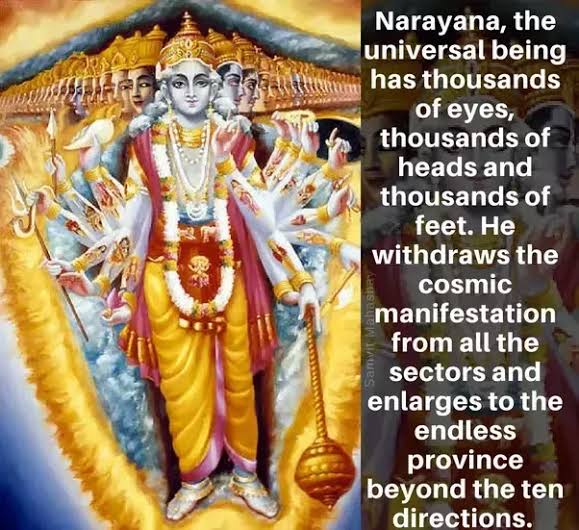NAME 94
Sarva-darśanaḥ सर्व-दर्शनः
Sarva-darśana means a treatise on various systems of philosophies. There are various systems of philosophies and the important ones are dvaita, viśiṣṭādvaita and advaita (dualism, qualified non-dualism and non-dualism). The right approach to realisation is to begin with dualism, where god is kept in a pedestal and worshipped with flowers, offerings, etc. Here god is treated as supreme and different from the worshipper. The concept iṣṭa devata is predominant here. The next is viśiṣṭādvaita, the qualified non-dualism. Here, individual soul is different from the Brahman, but the soul depends upon the Brahman for its existence and has to ultimately become one with the Brahman. Dvaita philosophy is accepted by many and is the philosophy of all the Upaniṣad-s. It says “I am That Brahman” and affirms that Brahman and the soul are not different. An authentic scripture of viśiṣṭādvaita is “Vedārtha Saṅgraha” of Śrī Rāmānuja.
Yet another explanation is possible for this nāma. Sarva means everywhere and dsarśana means seeing. Viṣṇu looks everywhere. This reaffirms an exclusive quality of the Brahman, all pervasiveness, the omnipresent nature. No action goes un-noticed by Him. He notices all the activities of the universe, remaining only as a witness. He does not part take in any of the actions that unfold in the universe.
Bhagavad Gītā (XIII.13) says, “He has many hands, feet, eyes, heads, mouths and ears pervading everywhere.” Puruṣasūkttam begins by saying, “sahasraśīrṣā puruṣaḥ | sahasrākṣaḥ sahasrapāt | सहस्रशीर्षा पुरुषः। सहस्राक्षः सहस्रपात्.” This means that the Brahman (Puruṣa) has thousands of heads and thousands of eyes. Thousand means infinity. Omnipresence of the Brahman is being discussed through attributes. Sarvadarshanah – He is Omnipresent
Sri Adi Sankara interprets this as ‘Sarvaani darshanaatmakaani aksheeni yasya sah – He has eyes that see everything’. Sankara gives the following reference from the Sruti – “Vishvatash cakshur vishvaaksham – –One who has eyes on all sides – One who has a Universal eye”. (TaittirIya Aranyaka 10.1, 11).
Sri Parasara Bhattar interprets Sarvadarshanah to mean ‘He shows everything’ or projects himself in a multitude of forms and dimensions to his devotees.
Swami ChinmayAnanda gives the following reference from the Bhagavad GIta(Chapter 13 Verse 14) – Sarvato’kshi shiro mukham’ – One who has eyes and heads everywhere.
The Lord is Omnipresent, all seeing and ever ready to shower his grace on his devotees.
Sarva-darshanah- This term, “All-seeing” is very appropriate in as much as the Supreme Consciousness has been defined and indicated in the Kenopanishad as, “That which the eyes cannot see, but because of which the eyes see”. It is the Seer in the eyes, the Hearer in the ears, the Speaker, the Feeler and the Thinker”. And since this Principle of Consciousness is One everywhere, as expressed through the equipments, It is indeed the One Seer in all ‘seeing’, by everyone, everywhere. The Upanishad says: and the Gita indicates Him as “One who has eyes and heads everywhere”.
Purusha Sukta.
९४. ॐ सर्वदर्शनाय नमः |
94. OM Sarvadarśanāya Namaḥ
Sarvadarsanah -This term, “All-seeing” is very appropriate in as much as the Supreme Consciousness has been defined and indicated in the Kenopanishad as, “That which the eyes cannot see, but because of which the eyes see”. It is the Seer in the eyes, the Hearer in the ears, the Speaker, the Feeler and the Thinker”. And since this Principle of Consciousness is One everywhere, as expressed through the equipments, It is indeed the One Seer in all ‘seeing’, by everyone, everywhere. The Upanishad says: and the Geeta indicates Him as “One who has eyes and heads everywhere”.
Sarvāṇi darśanāni (darśanātmakāni akṣiṇi) yasya saḥ / सर्वाणि दर्शनानि (दर्शनात्मकानि अक्षिणि) यस्य सः Whose eyes are of the nature of all darśanas, view of reality or One who is omniscient.
INTERPRETATION GUIDED BY SANT VANI (WORDS OF SAINTS)
Sarvadarśanaḥ
The one with all eyes.
Darśana here refers to the eyes that are meant for seeing. All eyes of all beings belong to Him. Therefore, He has eyes everywhere and He is all-seeing. The eyes are a sense organ, that helps to see and there is a beautifully revealing word for sense organs in Sanskrit – jnānendriyaṇi – organs of knowledge. The eyes help us see and know our world. Based on what the eyes see, we make a lot of conclusions about ourself, people around us and the world at large. This extends to the various Sciences – Botany, Zoology, Neurophysiology etc, as they exist today. The various instruments such as the Electron microscope, the MRI, the hubble telescope, only help to refine our visual perception, the basis of it being the eyes.
He, who sees everything and whose eyes are everywhere. He who is present everywhere and in all beings. His are the eyes of the Universe. (Śaṅkara) He who reveals his full glory and magnificence to his devotees. (Parāsara Battar) He who is the knower of, the master and creator of all the Vedas, Darśanas (philosophical schools).
The Puruṣa sūkta says, ‘sahasrāksaḥ sahasrapāt–one who has countless eyes and feet.’ Sahasra, one thousand, may be used in the shastra, not necessarily being a thousand only. It is like saying, ‘thousands of people go to the Kumbh melā.’ Does it mean a thousand, literally? It means that seemingly countless people go. What the eyes do, the ears cannot. The eyes see and sometimes they don’t. The extensive field of opthalmology researches the laws that makes the eyes see as well as the corrective measures that will enable eyes to see better. These principles are universal and in the commonality there is a law. Every law indicates the presence of Isvara.
The eyes are the upalakṣaṇa to say that all indriyas are His alone as he is all knowing. The Gītā says, ‘sarvataḥ pāṇipāda tat sarvato’ ṣiśromukham–the one that has hands and feet everywhere and heads, eyes and mouths everywhere’ (13.13).
The Taittirīya-āraṇyaka says, ‘viśvataścakṣuḥ’ and ‘viśvākṣam’(10.1,13), He has eyes everywhere. In the Śvetāśvataropaniṣad the Supreme Being is referred to as the Viśva-Cakṣhu (Śvet-Up-3.3) the Universal Eye. The Nārāyaṇopaniṣad (Nār-Up 13.1) also refers to the Supreme Being Viṣṇu as the Viśvakṣam. This is further confirmation of the universality of the Supreme Being, his all perverseness both within and without all beings. A recent TV commercial advertising a particular brand of CCTV(closed circuit television), has the tagline ‘uparwala dekh raha hai’, suggesting that the one who lives on top i.e. God is watching you. Here, it does not mean that Isvara is watching and stalking us. It is just highlighting that all eyes are his.
He is the one whom the various darśanas of the śāstras try to reveal. He is in the form of sarva-darśanas and also their subject matter. But at the same time, He can be properly understood only through Vedānta and darshan-śāstra.
Further this is another one of those gateway-names that appear at the beginning or end of a string – Gates that open up to names that either specifically talk about the greatness of that Supreme Being or are names that are ideal for contemplation and meditation and help open up the gateways to higher meditative states. The next set of names appearing in the next string will show this.
This name also shows that the Supreme Being Viṣhṇu is the knower of all the Darśanas or philosophical schools embedded across the vast landscape of the Sanatan Dharma. By knowing that one Supreme Being, we can know all that is to be known. This is the real meaning of the what Bhagavan says in the Bhagavad-gītā about giving up all Dharmas and taking refuge in him alone. It is not a call to reject Dharma (like some conveniently interpret it) but rather that he (Bhagavan) is great repository of all of that vast knowledge:
सर्वधर्मान्परित्यज्य मामेकं शरणं व्रज |
अहं त्वां सर्वपापेभ्यो मोक्षयिष्यामि मा शुच: || 18-66||
sarva-dharmān parityajya mām ekaṁ śharaṇaṁ vraja
ahaṁ tvāṁ sarva-pāpebhyo mokṣhayiṣhyāmi mā śhuchaḥ
This kind of Śraddhā that Prahlāda exhibited and reposed in Nārāyaṇa, where he surrendered completely to Nārāyaṇa:
Mātā nāsti pitā na ’sti na ’sti me swajano janaḥ…
“I know not mother nor father, or relative. It is Nārāyaṇa who is everything to me “
This name also completes the 10th couplet containing 10 beads and our garland now has 94 beads in it ☺️.
Derived from the Sanskrit word,शम्भल [Śambhala], Shambhala is a mythical place in the Himalayas. It’s also known as Siddha-ashram in the texts of Hinduism or Shangri-La in Chinese culture. In the Mahabharata and the Harivansh Purana, it is prophesied to be the place where Vishnu’s last incarnation, Kalki, will be born.
Swamiji conveys this gateway name in the most beautiful way on os.me which is indeed Bhagwat Gita from the Shri Mukh of Shri Hari Narayana himself for me flowing in the Guru Vakyam Param Vakyam. There is virtually nothing, absolutely nothing that is mentioned in the Vedas, Bhagwat Gita, Vishnu Sahasranama, Lalitha Sahasranama, Devi Bhagwatam, Srimad Bhagwat or any purana or any Darshan Shastras which will not be found there. This is the reason I continue to quote from os.me, what our Master has written while trying to understand the meanings of these 1000 names of Bhagwan that lead to Him.
Citing the beautiful wake up call in the Tibetan story of “The Gates of Shambhala”, Swamiji writes : “Sometimes, I’m asked why I don’t write more on scriptures and spirituality, something mystical, rather than scribbling on the practical issues of life?”
Swamiji writes his reason for using the platform of os.me to share his musings on life is not too different from the story of Shambhala. Life is too fast and too precious to not live it fully. That is, at times, we get so busy searching for our truth in the reality of some other world, that we completely forget to make the most of this life we have right here. We get so busy looking that we stop seeing.
He also says and I am excerpting here from that blog – https://os.me/the-gates-of-shambhala/
“I don’t deny that mystical stuff is fascinating and life can be a mundane affair and its challenges, undesirable. But, that’s what makes it beautiful. My mother’s mother was an incredibly simple lady who spent her life in service. Every saint coming to that town would make a stop at her home. Every afternoon, she would mop the temple floor. She died at the ripe old age of 92. Her skin was as soft as a baby’s; there was some tenderness that gave away her age but not a deep wrinkle. And she passed away exactly as she had lived: peacefully. No diabetes, no hypertension, no heart issues, no joint pains, no body aches. Perfectly fit. She never bothered with any tantra or sadhana. Her life was a prayer.
It is when we fail to appreciate the beauty of life, that we look to engage ourselves in lifeless pursuits. Nothing wrong with that at all. In fact, I fully agree that an intelligent mind can find this simplicity all too familiar, and, therefore, boring. Yet, the truth is, all sadhanas, whether that be kundalini, tantra, mantra, meditation, or any other, are designed so I fall in love with life. That’s the whole idea.
The more I am in love with my life, the bigger my heart will be to practice compassion and loving-kindness towards others.
Like the gates of Shambhala, some opportunities will only knock once. We can’t take for granted this life, our world and, the joys it has to offer. Depriving yourself of what’s natural or to indulge excessively just because you can are two ways of taking life for granted
*The Gates of Shambhala
If you let this moment slip away, it’s lost forever. “Now” never comes back.*
I don’t discourage you from looking, I do, however, urge you to not stop seeing. Don’t let your beliefs get in the way of your discovery. You don’t have to live the life of a mule when you can be the ruler. Shambhala was also named after the king who ruled it 2500 years ago.
The key, the lock, access to the gates of Shambhala, it’s all in your hands. Ikkyū 2 writes:
From the world of passions,
I return to the world beyond passions,
A moment of pause.
If the rain is to fall, let it fall;
If the wind is to blow, let it blow.
Only a genuine appreciation and love for life is beyond passion. Everything else is passion disguised in one form or another.
Also, let me in you on a secret. Randomly pick any five posts from this blog. Now, select five verses from any scripture of your choice. Read them alternately. Are they saying the same thing? A good chef doesn’t serve you the ingredients raw or talk endlessly about the recipe. Instead, s/he will serve you the meal. Each post that I write is my humble attempt to serve you.
Squeeze the most (not the hell) out of your life. Each moment gone is many more lost.”– Om Swami



